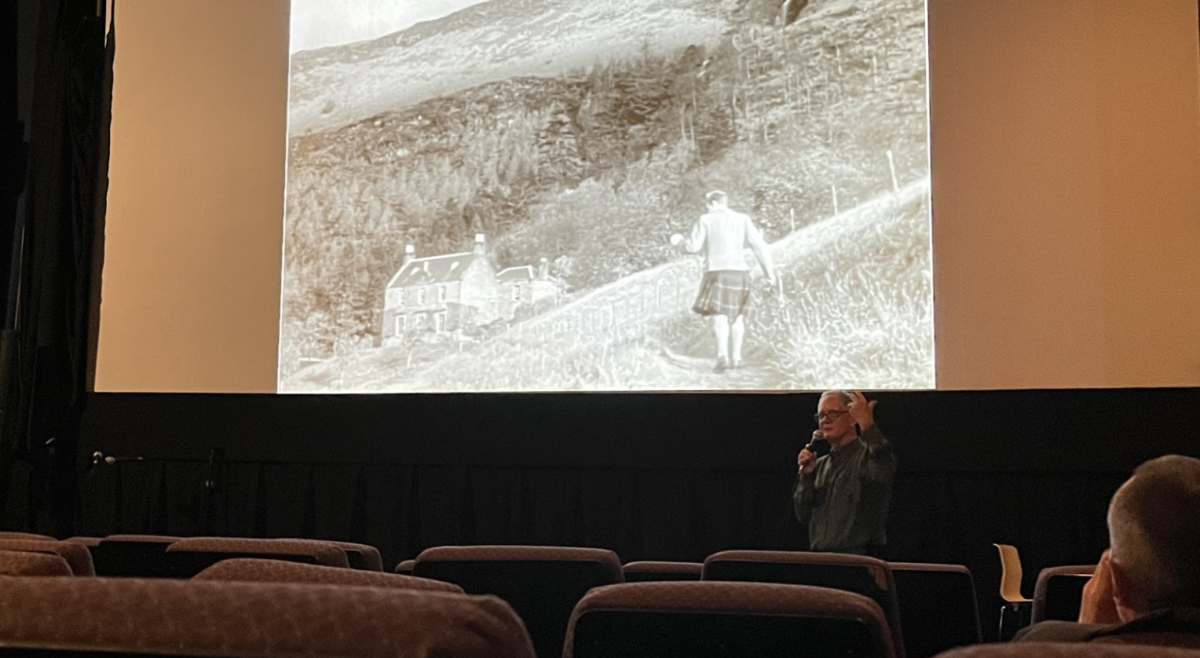
Ty Burr was a 2017 Pulitzer Prize finalist in Criticism and works as a film critic for The Washington Post. (Jisu Lee / For The Heights)
In the half-full Theater 2 of West Newton Cinema on Thursday evening, moviegoers were dipped into a dreamy, fog-infused vision of Scotland via the classic British romantic comedy I Know Where I’m Going! (1945).
Boston native and film critic Ty Burr selected the film because of a personal connection he has to it.
“This was my mother’s favorite movie,” Burr said. “As a young woman growing up in Boston—this was a movie that was released in the United States and played in cities but not in smaller towns—it was something exotic. I think for my mother and her generation, it fulfilled the same niche as Outlander.”
Directed by the filmmaking duo Michael Powell and Emeric Pressburger, I Know Where I’m Going! centers a headstrong young woman named Joan Webster, who’s engaged to marry a wealthy, older man on the Scottish island of Kiloran. Stranded on a nearby island due to a storm, she connects with Torquil MacNeil, a Royal Navy officer native to Kiloran.
“The locations have been tourist attractions for years, because this movie is quite well-loved in England,” Burr said. “It’s kind of ironic that they created this ‘filmic’ world within this movie that’s perched on the edge of realism and fantasy.”
I Know Where I’m Going! is every bit a love letter to Scottish culture as it is a critique of materialism. Kilts, bagpipes, gorgeous landscapes, and camaraderie among the working class who disparage Joan’s rich fiancée are highlights. One of the film’s most electrifying, joyous scenes was a couple’s diamond anniversary cèilidh, where Torquil finally persuades Joan to dance with him.
“Powell really, really wanted to get across the real Scotland, and this movie was unusual in that it’s the first British movie to go to Scotland to cast locals, to try to get the true flavor of the place instead of having fake studio Scotland,” Burr said.
After the film, Burr led an enlightening mini-lecture and discussion with his cinephile audience. Topics ranged from Powell and Pressburger’s careers and the film’s editing to production tidbits, such as the lead actor, Roger Livesey, never setting foot in Scotland due to scheduling conflicts.
“Powell said, ‘Oh, we’ve got to think of a film to make this year or we’ll be drafted into the service,’” Burr said. “They shot the film in early 1944, and D-Day was in June—the end was in sight. I think that actually imparts a tone to the film that there’s a future about to happen.”
For nearly 20 years, Burr—a Bostonian raised in Brookline and a 2017 Pulitzer Prize finalist in Criticism—served as the film critic for The Boston Globe. Now, Burr is a critic for The Washington Post and writes his own newsletter, Ty Burr’s Watch List, but remains connected with his local community by hosting Ty Burr’s Movie Club at the West Newton Cinema every month.
There was a surprisingly intimate dynamic among the audience members—people laughed at the same moments during the film and naturally bounced off one another in discussion. Inside references to the British comedy-drama Local Hero (1983) and a former English major’s insights on the symbolism of the curtains and bagpipers flew across the small room.
“You guys are full of information!” Burr said, to another burst of laughter.
When asked more about how the film influenced Burr, he explained that he hadn’t seen the film until he was in college, but that when local cinemas in Boston around the ’60s and the ’70s started showing older movies, college kids found a new shared love with their parents, despite a generational and political divide.
Moviegoers were delighted by the film itself, as well as Burr’s knowledgeable take.